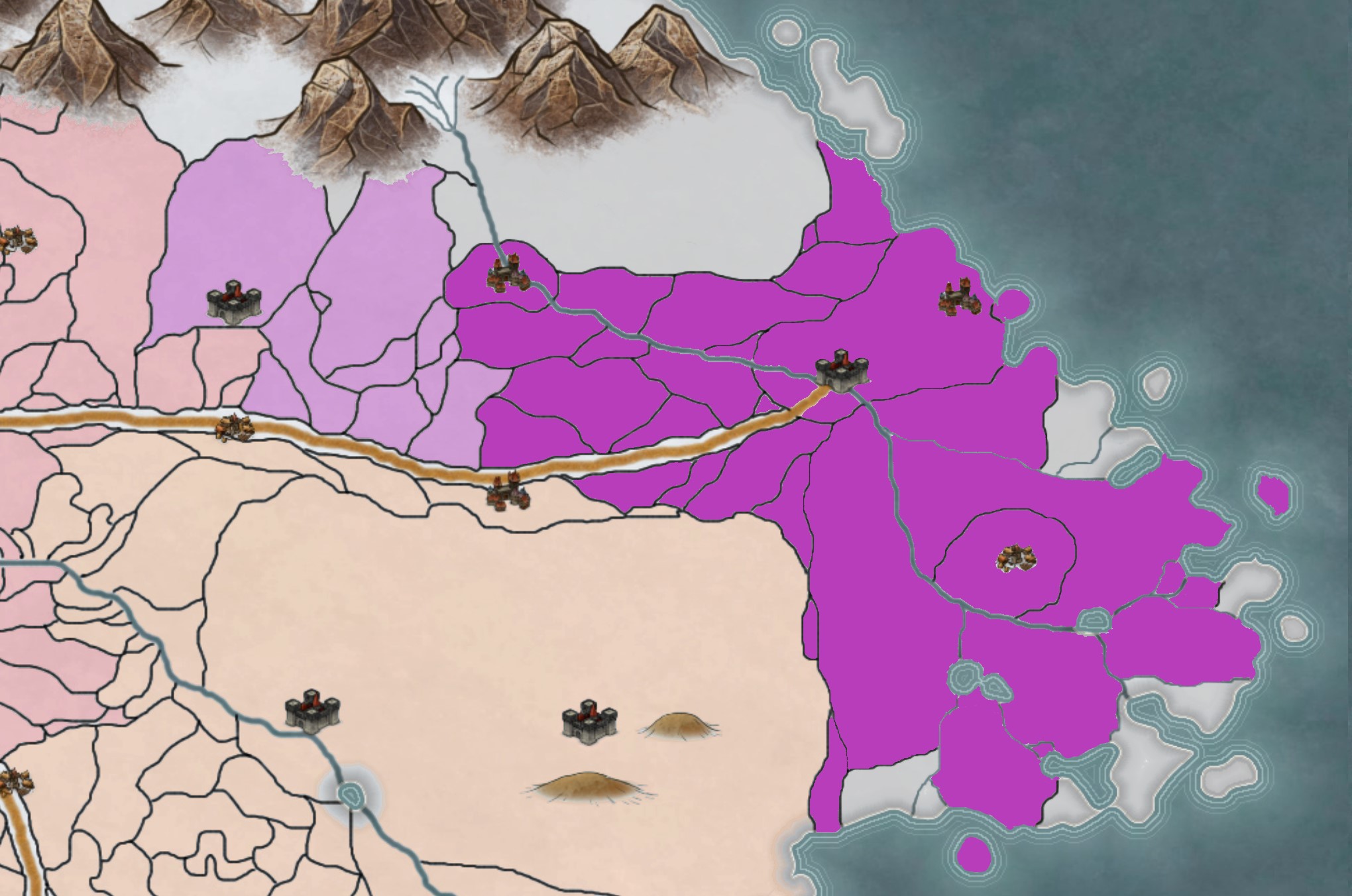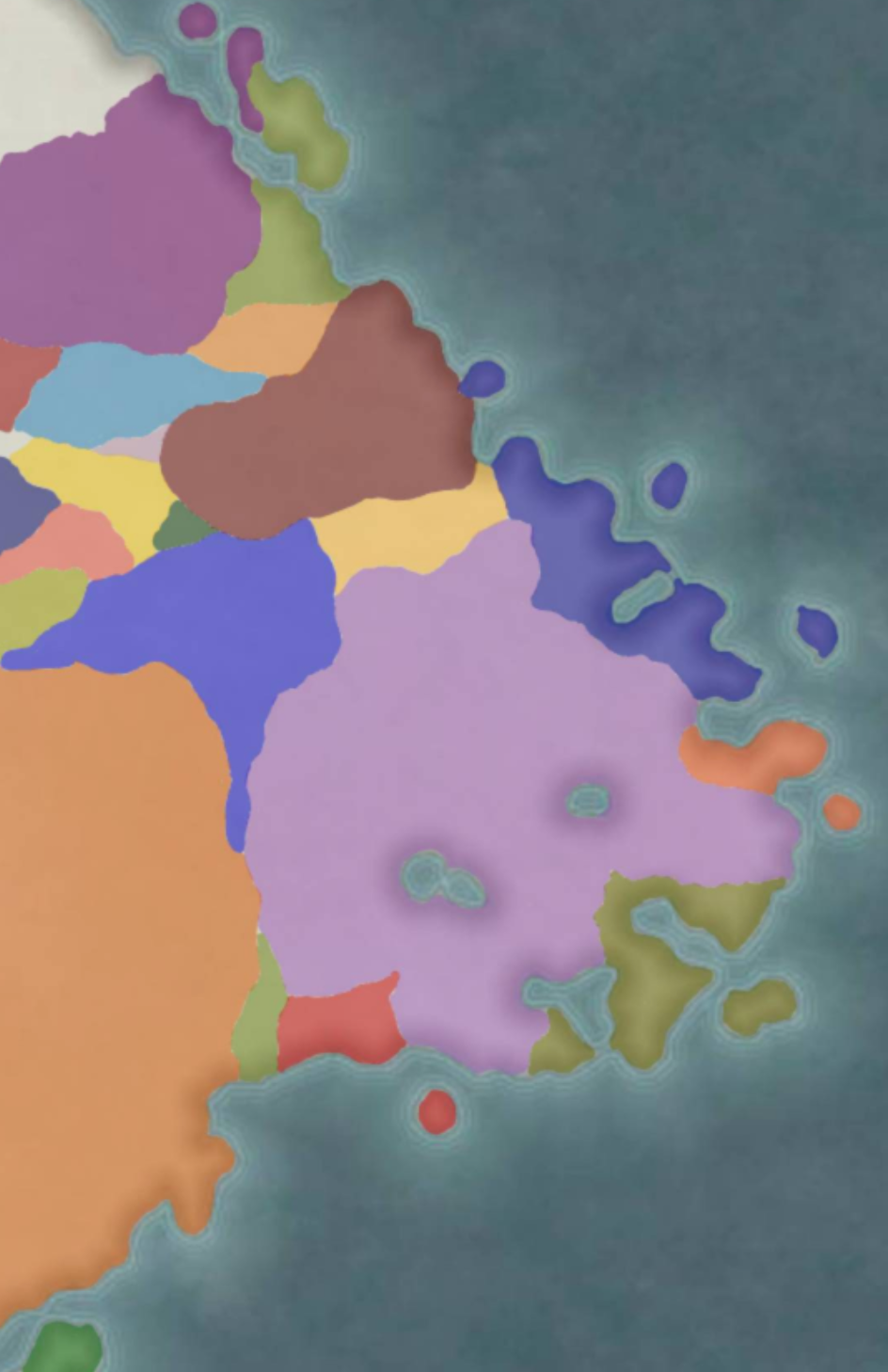The Far East: Dhily and Wensyar
Beginnings
Around the years -5486-10 rich rock and meltals were discovered in the north east of Ecoth which were economically worth mining and in high demand at the time. Many poorer families from areas such as the Hana Dessert and central Ecoth migrated to the area that later became known as Wensyar. They founded independent colanies but were continually bothered by the local native tribes who were unhappy with the new arrivals. They delt with this problem by fortifying their cities, the most famous of which was Fort Star, a large walled city that formed the centre of trade and exports in the region. However whilst this protected the richer classes and tradesmen, life was still tough for the poor miners who lived out in the hills.
East Native Purge (-5343-42)
In -5343 A man named Votox Wifano who had claimed to be harrased constantly by violent locals started a movement against the natives in his area. This in turn led to a movement of settlers which slaughtered native tribes in so called 'prentive attacks.' Millions of natives were forced to flee south into the marshes of Dhily, or north to the mountains. Many peaceful tribes were exterminated and those who tried to fight back did so with little sucess. Even after the year long movement ended in -5342, hostilaties remained between the settlers and the few natives who remained in the region. This event would become known as the East Native Purge and defined the relationship between the settlers and natives for centeries to come...
Inner Conflict
Coming SoonThe East Wars Begin
Coming SoonGold Rush (-4922-4761)
In the year -4922 gold was discovered in the marshes of Dhily. Once again mass migration occured to the region as settlers moved south to try their luck diging in the mud for their fortune. Other precious minerals were also discovered in the area leading to further interest from larger entities such as Urserons. There were several problems with the region though, since not only was it wet, marshy ground, unfit for construction, but also there were many native tribes who had migrated to the area after the Eastern Native Purge who now, once again, found themselves subjected to outside rule. The local tribes distupted inferstucture in the area as much as they could, destroying equipment and raiding camps. But this only led to them being hunted and exterminated at an accelerated pace.
The Urseron of Dhily
In -4922 the kingdom of Liskon was eager to expand southwards into the gold rich marshes of Dhily. Leading the expeditions was a guild of merchants hired by the kingdom to move south and set up supply lines and settlements. Despite local resistance the merchant guild, who quickly became known as Glift Iglus or gold seekers, managed to start up many significant mining projects, quickly becoming incredibly wealthy off the back of gold trade.
By -4918 they controled much of the wealth and industry in the north east of Dhily, even founding the city of Cilus on a plateau in the marshes. They also controlled much of the population who worked under them, mining and working the gold. They had their own armed forces, which they used to fend of the natives from mining settlements and held a semi-independent government from Liskon in the city of Cilus.
In -4918, fearing the power of the Glift Iglus, the king of Liskon sent them a letter, asking they hand control of the region back over to the royal family, as Cilus was to become the new royal capital. Unhapy to give up their power, the Glift Iglus marched their private army north, towards the current capital of Liskon. After a loss in battle and a brief skermish outside the gates of the capital, the King oh Liskos was forced to graunt the Glift Iglus control of the entire region of Dhily.
With their power secure the Glift Iglus set up their capital in Cilus and began to trasform Dhily into a merchant kingdom or urseron.
The Urseron of Tibil
Tibil was another pre-gold rush kingdom however, unlike Dhily, it had already been run by a council of merchants before -4922. Once gold was discovered in Dhily the Ureseron wasted no time expanding their influance south into the marshes. They promised land in Dhily to anyone who would fight on their behalf and there were plenty of takers. Many poorer citizens, with dreams of the wealth gold could bring to their families quickly signed up and Tibil quickly expanded their influance south. However they also took control of teritories to their north and west which gave the Urseron better access to the Great Easter Road. Tibil became the only Urseron where gold was both mined and traded as, being the first Urseron, Tibil controled the markets and flow of gold out of the Urseron. This was different to Dhily who relied on foreign merchants to trade the gold they mined. At the time this made Tibil one of the wealthiest Urserons, allowing it to build elaberate cities and trade for expensive goods.
Captirian Interferance
The Captirian Empire had also take note of the developments in the east and wanted in on the potential trade. They were significantly further away from Dhily than other participants in the gold trade but were much more advanced in their oceanic trade than any of the other kingdoms. In -4913 a veteraned captain and explorer Doyous Farn departed from the city of New Capti with five ships headed eastwards. Farn was an experianced sailer who was familiar with the rough seas off the Buzhanan coast and managed to successfully reach the gulf of Zuu by early -4912. There he met up with the Zuulwse people who had only recently come under Buzhanan influance. It is unknown whether Farn knew this but he quickly started making alliances, promicing the locals a shar in gold if he was allowed to use their teritory as a stopping point on the way to Dhily. He founded a settlement which would eventually become known as Sacreen in the gulf of Zuu and sent word of his success back to New Capti.
The next summer he took half his fleet further east. He noted that the people to the immidiate east were hostile, however those further east still in Dikabil were not. He wrote that they were still fairly 'primative' and that Capti could easily take their land in an effort to mine for gold. He had a fairly mixed reception in Dikabil making some alliances but was fore to return to his contingent in Sacreen later that year as a new threat had emerged.
Buzhana had discovered the Captirians in Zuu and were determined to expell them. Farn's forces in Sacreen had sent a letter back to New Capti requesting assistance and begun to fortify their settlement. The Captirian force was relativly small, even when Farn returned however they had made alliances with the local Zuulwse people who had agreed to fight for them in return for a future hand in the Captirian gold trade. However the settlers were still outnumbered and even after reinforcements ariver from New Capti a month later, were forced to retreat back westwards, leaving the Zuulwse to fight alone. Buzhana heavily punished the area and fully brought Zuu into their empire.
The captirian throne denied any involvement in the events and managed to avoid full on war with Buzhana, and they did not attempt to get involved with the gold trade again.
Buzhana
Buzhana lay to the west of the gold marshes of Dhily but crucially ocupied the vast Hana dessert, a barrier which prevented easy trade with the west. However, it only took the idea of the riches the gold trade could bring to the empire to encorage Notach Vaggh III to decide to invest in the area. He restored the city of Ravuuka to the east of the desert and opened up a path of wells and outposts along a new trade route in an effort to direct the trade of gold through his empire. This worked incredibly well as the Path of Sand became the most trodden trade route for gold leaving Dhily, supplying the precious metal to Capti, the Suhuvan Empire, Xyanvia and many more western kingdoms.
This made Buzhana incredibly wealthy and they quickly began to strengthen their presence in the east. However it also took buisness away from the Uresron of Tibil who had also aquired a significant amount of wealth over the last decade from the gold trade. At first they tolerated Buzhanan dominance of trade but after -4888 when a Tibilian merchant was killed on the Path of Sand, Tibil decided to act against Buzhana.
Fearing Buzhanan power, they hired a band of mercenaries to pillage the Path of Sand and disrupt trade within Buzhana. Unfortunatly the mercenaries were not quiet about their employers and Buzhana quickly began amassing a force to invade Tibil.
The merchant leaders of Tibil panicked, quickly gathering an army in an effort to defend their teritory. However, this army was relativly small and poorly trained. Tibil was therefore forced to call back their merchant army, a group of skilled and elite individuals who they used to protect their gold merchants from attacks. The Merchant Army wasn't a very good traditional force, but they specialised in ambush tactics and gerrilla warfare.
Tibil was aware of Buzhana's frequent use of flanking and surprise attacks i traditional warefare so chose to make their stand in a narrow gorge, positioning their traditional army at its centre, and the merchant army up above. The Merchant Army was successful at taking out Buzhana's flanking forces atop the george then managed to flank the Buzhanans themselves, trapping them in the gorge. Whilst the Buzhanans were eventually able to escape, they were forced to retereat.
Tibil has successfully defended their teritory against a much larger foe, however the battle had resulted ih high losses in their Merchant Army which meant that they were less able to protect their merchants and control trade. It also meant that when Buzhana returned the following year, in -4886, they were unable to repel the desert empire and were forced to give up a potion of their teritories.
Yisper Kinue
As settlers began moving south from Liskon into Dhily many of the native tribes began to worry about a repeat of the East Native Purge where the settlers would come and take their land, pillaging their way to gold. For this reason, in -4918 several native tribes on the eastern coast of Dhily gathered and formed an entity known as Yisper Kinue or the Great Alliance. This was a native alliance which aimed to pool the reasources of the various tribes into defence and trade in an effort to prevent further settlers from taking their lands.
The alliance quickley grew and even began to mine gold for themselves from their own teritories which they traded with Wenstyr, Tibil and Dhily. However the settlers mostly left Yisper Kinue alone for the first few decades of the gold rush. Not wanting the alliance to fall appart, the leaders of the tribes decided that Yisper Kinue needed to focus on a major project which would help to furhter unite the native tribes. This project came in the form of the fortress at Almurid.
The river fortress was designed by an exiled Wensyri architect in -4906 and was reportidly very popular amoung the various tribes. The fortress was built into the bogs created by a river delta, making it inaccesible from below with the exception of a single drawbridge and a harbour. It consisted of a series of walkways and towers that could all be isolated by 17 seperate drawbridges. However there were several architectural dificulties building in the marsh and the Fortress at Almurid took over 20 years to contruct.
Those of Yisper Kinue hoped it could be a last resort defencive position if the settlers did come for them. The irony was that it was originally the settlers who built mighty fortresses like Fort Star to protect themselves from the natives, now the roles had been reversed.
Almurid quickly gained a reputation as an impenetrable fortress and acted as a deterant more than anything else, allowing Yisper Kinue to to be left alone for many decades after its contruction.
Wenstyri Alliance
Early Growth
As the glod trade started to dry up in the -4700s and with the collapse of major trading states like the Captirian Empire, many smaller states in the far east began to fear for their economies. Once more the Traiphotian Empire had just united in the west and was also mining and selling precious metals to the major powers. This hurt the far east as their isolation suddenly cut them off from the new markets, which were more convinient for empires such as the Dynasty and Buzhana to access.
This is why the Wenstyri Union took off at this time as many smaller states hoped that by being part of a larger entity they would have more oppertunities for trade. The alliance centred around Wenstyr, which had always acted as a hub for trade in the region and hadn't been as reliant on gold for the last centuries, so has less of an economic crisis. The Union mostly focused on trade with the Eastern Kingdoms, Buzhana, eastern Captirian successor states and other states in the far east. It didn't make anywhere near as much as the far eastern kingdoms had done during the gold rush, however many smaller states saw it as neccessary to keep themselves afloat.
Absorbance of Dhily
Wars with the Dynasty
States Surender to the Dynasty
Comming Soon
Remove these ads. Join the Worldbuilders Guild










Comments